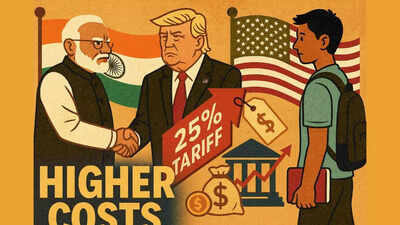India-US trade deal standoff: Will Trump’s 25% tariff push turn the American dream into a pricier gamble for Indian students?

It was not a late-night tweet this time but a calculated, headline-grabbing announcement. On Wednesday, President Donald Trump declared his intention to impose a 20–25% tariff on Indian exports to the United States starting August 1. While no formal notification has been issued yet, the message was clear: Trade relations are once again a bargaining chip in Trump’s transactional diplomacy, and the ripple effects may reach far beyond boardrooms, potentially unsettling the budgets of thousands of Indian students studying in the US. Indian students studying in the US may be silent collateral in this trade war, caught in the crossfire of protectionism, inflationary pressures, and policy unpredictability. If Trump’s tariff warning translates into action, the economic fallout could stealthily increase the cost of an American education—not through direct tuition hikes overnight, but through a chain of price escalations and currency jitters that students can neither foresee nor control. Read on to know how.
Higher tariffs mean costlier essentials for students
Tariffs are taxes imposed on imported goods. When Washington raises duties on Indian products, exporters often absorb some costs initially, but eventually, the burden passes to consumers. Among those consumers are Indian students in the US, dependent on imported textiles, generic pharmaceuticals, packaged foods, and affordable tech accessories from India.Imagine the average student’s essentials basket: low-cost medications couriered from home, Indian spices and ready-to-eat meals, traditional attire for community events, or a budget smartphone shipped from India. A 25% tariff inflates these costs, with US retailers adding their own markup. Small increments—$5 here, $20 there—compound over semesters, subtly eroding tight student budgets. Past tariff hikes on Chinese goods during Trump’s first term led to price jumps of 10–20% on consumer electronics within months, a pattern likely to repeat with India as the new target.
Currency volatility: The Rupee pays the price
Trade wars rarely stop at tariff headlines—they unsettle currencies. The Indian rupee has historically weakened whenever US protectionist measures targeted Indian industries, from steel to IT services. A depreciating rupee makes every dollar of tuition, rent, or groceries more expensive for Indian families remitting funds abroad.In 2018, during an earlier US–India tariff tussles, the rupee slid from 65 to 74 against the dollar in under a year. That plunge translated into a ₹4–6 lakh hike in real costs for Indian students studying abroad—even if tuition remained static in USD terms, highlighted experts. A repeat scenario in 2025 could easily shave a semester’s worth of savings off a middle-class parent’s budget, forcing families to dip into loans or defer planned expenses.
Non-resident tuition fees could see upward pressure
Universities don’t operate in isolation from trade tensions. Many US campuses depend on endowments linked to foreign investments, philanthropic grants, and revenues from international students themselves. A hostile trade climate reduces cross-border funding and sours the political mood toward non-resident enrolments.While there is no formal link between tariffs and tuition, history suggests a policy spillover effect. When Trump tightened H1-B processing and raised visa fees post-2018 trade conflicts, several public universities, particularly state-funded ones, raised international tuition to offset uncertainties in foreign student inflow. Indian students, already paying two to three times the domestic rate, could again find themselves footing the bill for geopolitics they neither caused nor can influence.
Scholarships, research and academic inputs at risk
Tariff wars don’t just affect goods—they alter the ecosystem of academic collaboration. Higher tariffs can cool bilateral research projects involving technology transfer, biotech materials, or software imports, making joint labs costlier to run. Some U.S. universities might scale back India-focused scholarships or pause exchange programmes, wary of volatile trade relations.Even tangible educational tools can suffer. Specialised textbooks, lab equipment, academic software licences sourced from India or routed via Indian partners may become pricier under higher duties. The academic cost curve, once upwardly nudged, rarely comes down quickly, meaning long-term damage to affordability and access.
The hidden tax on dreams
For decades, studying in America has been the pinnacle of global academic ambition for Indian families. A 25% tariff on unrelated trade goods may seem distant from this dream, yet it operates as a hidden tax, stealthily raising costs through a mix of inflation, rupee depreciation, tuition pressures, and weakened scholarships.Trade wars are never fought just at ports; they leak into classrooms, dormitories, and campus job markets thousands of miles away. Students planning to study in the U.S. now face a new uncertainty: that geopolitics, as much as grades and test scores, could determine the true cost of their education. In this evolving landscape, Indian families may need to hedge more carefully—factoring political risk into an academic journey once thought immune to tariff wars.TOI Education is on WhatsApp now. Follow us here.




